Get away from the tourist throngs in tranquil Baracoa, Cuba
Due to its geographic isolation, Baracoa, Cuba, is just beginning to be discovered by tourists. Those who venture to this remote northeastern corner of the island will discover an almost unspoiled colonial village surrounded by secluded beaches and virgin rainforest. On the horizon looms the most recognizable local landmark, a table-topped hill called El Yunque.
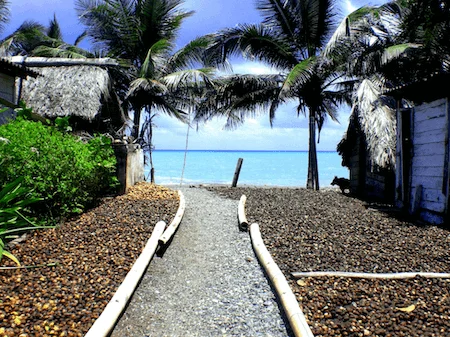
Along the eastern edge of the village runs the Malecón, a miniature of Havana’s seaside promenade, which ends in a park dedicated to Christopher Columbus, who arrived here in 1492. His statue,hand-hewned out of a giant tree stump, stares inland with a stern expression. Downtown, in the Cathedral Nuestra Señora de la Asunción, you can see a silver-plated cross he is said to have planted on the beach near what is now beach of the Hotel Porto Santo. To the north-west of town lie the tranquil beaches Playa Maguana and Playa Nibujón. Playa Maguana is the tourist beach, featuring restaurant and bar service, while the Playa Nibujón is more rustic and frequented by the locals.
Located farther inland one can find the UNESCO Biosphere Reserve known as Cuchillas de Toa (The Ridges of river Toa). It is one of the world’s last untouched rainforests and it contains large number of endangered plant and animal species. Among these species is the Cuban land snail, about two inches in diameter with striking spirals of colour. It is advisable to hire a guide for trekking or hiking excursions in this reserve. Official government guides can be found at the Office of Natural Parks. However, local people are happy to act as guides and are often more affordable and entertaining. This common practice is technically illegal, so some discretion is advised, such as not handing over bills in public.
After an active day of hiking and swimming, return to the homey atmosphere of your bed and breakfast, or casa particular, and enjoy a home-cooked meal. Be sure to advise the proprietor of your meal choice in advance. For less than a McDonald’s Happy Meal your hostess will prepare a feast of traditional Cuban Creole food: fried chicken, rich, beans and sweet plantains, or better still, a typical Baracoan meal of fresh Black Market seafood, fish stuffed with plantains, garlic-rubbed shrimp or lobster smothered in butter.
Architecture
According to Dr. Martín Gutierrez, and I quote: ‘The sensation which Baracoa produces in we visitors is one of having been deceived. We think we will find an ancient place, instead of which we encounter a rejuvenated Baracoa. We believe that as in Trinidad, we will find exciting monuments to the past… however, in Baracoa some buildings from past times still remain: the Fort of La Punta, the Matachin Fortress, the old Spanish jail of Seboruco Hill’… the plan of Baracoa is of irregular form with streets which become wider and narrower, uniting and forming small squares in which have been built the four parks which stand in the city, all of which are small and of a triangular shape. When we arrive at the colonial part of the city via the viaduct La Farola, that monumental, majestic marvel of national architecture, passing by the Matachin Fort Municipal Museum we find the first of them.
 Martí Park
Martí Park
Located in Martí Street on the corner of Ciro Frías Street. Here, construction work was begun in 1936. It was not however until 1942 that local Freemasons commissioned the park in recognition of the fact that Baracoa was the place chosen by the Apostle and it didn’t even possess a small statue with which to revere his memory.
Maceo Park
Stands in Marti Street at the corner with Juración Street. It was rebuilt by the construction guild in 1947. On a pedestal stands a bust of the deputy lieutenant of the Liberating Army, Antonio de la Caridad Maceo y Grajales, from whom it takes its name. The sculpture was created by the distinguished local artist Eliseo Osorio Cordero.
Independence Park
Located in Maceo Street near the corner with Ciro Frías Street. This is often referred to by older people as Central Park and has been considerably changed over the course of the years. Here we find the bust of the legendary Indian Hatuey by the prestigious artist Rita Longa, donated to a local Masonic lodge by José Bosch and unveiled on 1st April 1953 by Carlos Manuel Piñeiro y del Cueto.
Victoria Park
Stands in Martí street at the corner with Roberto Reyes street. The bust was placed there in 1942 at the petition of a local Masonic lodge. This piece was also created by the artist Eliseo Osorio Cordero. On one of its sides it says ‘Immaculate Patriot, Gentleman, exemplary citizen’. The motive behind the inscription is to highlight the qualities of this humble, generous and unequalled patriot who came from our area.
Spanish Forts
After the title of capital of the island had been transferred to Santiago in 1515 the Spanish gradually forgot Baracoa. This caused the city to be converted into an important centre of Caribbean piracy. In 1739 the Captain General of the Island, Juan Francisco Quemes de Horcasitas, in order to control smuggling in Baracoa and defend the people from pirate attacks, required the governor of Santiago, Francisco Antonio Cajigal, to make a topographical study of the city preparatory to creating the conditions for its defense. The work was given to the Commander of the Parade Ground of Baracoa, Pedro Oviedo, who between 1739 and 1742 built four fortresses. These, together with the town’s three towers, were designed to protect the area in its entirety and earned it more respect amongst the sea rovers, particularly after a band of pirates that tried to disembark at the Ensenada del Miel were imprisoned and hanged.
 Majana Fort
Majana Fort
Built on the marine terrace of Majana whence it takes its name, located in the Ensenada del Miel. Now completely destroyed.
Matachín Fort
Built on Esteban Point, whence it takes its name, for the people of Baracoa (without knowing why) began at the beginning of the c.19 to call it Matachin. When in 1807 the ship of an English pirate called Winchester arrived at the Ensenada del Miel, the Baracoan counter-attack was so decisive that some pirates fled and others were taken prisoner, evidence of the strength of Baracoa’s arsenal. In 1868 it became a guard post of the Spanish army for the recognition and registry of all those entering and departing from the city. The people protested at the arbitrariness of this measure which was repealed in 1887 but subsequently reinstated in 1895.
After the installation of the pseudo-Republic, it was used firstly as a bastion against the pirates and later was used by the Spanish as a prison. Later it was used as a shelter by a group of desperate families which gathered there in search of refuge. So numerous were the misfortunes that rained down upon them that a sinister name was given to their temporary home: “The Castle of the Damned’. On 10th October 1981 the Matachín Fort Municipal Museum was inaugurated. This contains a brief account of Baracoa’s history from the time of the Indians and includes the most significant twentieth century facts and events concerning the region.
Seboruco Castle
Built on the high plateau of the Seboruco Hill, in the south east part of the cape, it was endowed with heavy modern artillery for the better defense of the area up to 1800. Between 1854 and 1868 various alterations were made to it and in 1898, during the North American occupation, it was used for the accommodation of those troops. By order of the interventionist governor of the island, Leonard Wood, some enlargements were made to it, completed in 1900. In 1915 the name of “Seboruco Castle’ was changed to Sangüily Castle, in memory of the general of the liberating army. On 31st December 1979 it was converted into the Hotel El Castillo.
Punta Fort
Construction located in the extreme north-east of the town. During the pseudorepublic it housed a radio telegraph office. Now it contains the Guama Restaurant.
Note: In addition other fortifications existed which have disappeared over the course of time: these were the Elvira, Maraví, Nibujón, Guandao, Mata and Capiro Forts.
Towers to control the entrances
The following towers were built during the nineteenth century to control the entrances and exits to the city:
- Joa Tower
- Paraíso Tower
- Caguasy or Sabas Marín Tower
Museums in Baracoa
Matachín Fort Municipal Museum
Ancient Spanish fortress built during the first half of the eighteenth century for the protection of the city from the attacks of corsairs and pirates. In it you will find a brief account of the history of Baracoa, from indigenous cultures to more recent historical facts. It was inaugurated as Municipal Museum on 10th October 1981.
Paradise Cave Archaeological Museum
The Paradise Cave Archaeological Museum is a marvellous facility for lovers of history and archaeology, situated in a colonial ambiance on the second terrace of Seboruco, known as Paradise Heights. The cave was probably formed during the quaternary period; the area in which it is located is rich in remains of our first population.
The cave-museum contains three galleries in which one sees a collection of prints and free-standing petroglyphs from different areas of the region of Baracoa, which bear witness to the cave painter’s art as practiced by our pre-Columbian ancestors. There is also a collection of decorated pottery embellished with beautiful zoomorphic and anthropomorphic drawings, and some ceremonial pots of great archaeological value, for many of them are unique in Cuba. Visitors may also see a representation of a Taino burial with its funerary offerings. Inaugurated as a museum on 24th December 2002.
Veterans’ Centre Museum
Here there is a permanent exhibition based on the history of underground fighters, the struggle against bandits, the rebel and internationalist armies and those who fell in the various internationalist missions in which the people of Baracoa have participated. Inaugurated as a museum in 1992.
Geography in Baracoa
Landscapes
The most beautiful landscapes in Cuba are found in Baracoa and anyone who thinks that is an exaggeration is invited to come and see them. The palm is present in all the panoramas in extraordinary profusion and in an unequalled size. The sea, rivers, mountains and forests in this area at the northeastern tip of Cuba pro vide excellent conditions for ecotourism. The mountains are covered with ram forest, pine, holm oak and gallery forests. Baracoa, the first Spanish settlement in Cuba, was founded on the narrow coastal plain where the many rivers ¡n the area run into the sea. The vegetation is exuberant, because the area is one of the wettest in the country and its abundant network of rivers means that the predominant colour in the region is green. Amongst the best-known rivers are the Yumuri, the Miel, the Macaguanigua, the Duaba and the Toa.
 El Yunque
El Yunque
An imposing outcrop of limestone rock, which the Admiral Christopher Columbus immortalised on 27th November 1492 when he wrote in his diary “and at the head of it in the south east part, stands a cape in which there is a high and square mountain that looks like an island…”. This is considered irrefutable evidence and has helped historians to determine the date of discovery of what would later become the first of Cuba’s settlements. The Yunque is situated between the banks of the rivers Duaba and Toa, its highest altitude above sea level is 575m, it is 1125m long and has a total area of 461000 square metres. Its flora and fauna are generally exciting, but particularly important is the Coccothrinax Yunquensis, endemic to this zone and sister to our Royal Palm. Miguel Castro wrote “when we find ourselves at the entrance of the Yunque, we are witnesses that the Royal Palm can easily sustain the sun and that Paradise exists upon earth”. It was the refuge of the natives who fled their colonizers and of the maroons and later became an observation point for the Mambises. For all these reasons the Cuban National Commission of Monuments took the decision on 25th December 1979 to declare it a National Monument, which proclamation was made on top of the mountain on 2nd April 1980, by the president of the commission, Dr. Antonio Núñez Jiménez.
Alexander von Humboldt National Park
The park owes its name to the eminent German naturalist, known as the second discoverer of Cuba due the numerous and important studies which he made of the country. The Alexander von Humboldt National Park has historically been an area of land little used by man, with only one archaeological site from the pre-Columbian period being known; this is located in the coastal zone of Aguas Verdes. During the eighteenth and nineteenth centuries some peripheral places were used as refuges or camps by maroons. It was not until the beginning and middle of the twentieth century that the land was used for the cultivation of coconut palms and cacao. In the zone of La Melba mining of chromium and for the mineral industry in general was developed.
The park began to be laid out in the 1960s, with the declaration of the Jaguani and Cupeyal del Norte nature reserves. This continued into the 80s with the proposal of the Ojito del Agua Refuge, associated with the last sighting of the Royal Woodpecker, a last remnant of this species which was already extinct in its other habitats in the United States and Mexico. In this unique ecosystem there are unique flora and fauna which have the highest indexes of endemicity in the archipelago. In 1996 these protected areas were united to found the Alexander von Humboldt National Park, the most important biosphere reserve in the Caribbean basin, which with Cuchillas de Toa, in 2001 was declared a UNESCO World Natural Heritage Site.
El Tibaracón
Amongst the phonetic peculiarities of the region we encounter the word Tibaracón, which means the existence of a sandbar accumulated by the waves at the mouths of the rivers which arrive at the coast with slow-moving waters. Their lack of pressure means that the sandbar obliges them to change ourse and follow a route parallel to the coast, until they arrive at a place where the waves have less force. On occasion, a river is obliged to run for a kilometre before finding an area through which it may pass to the sea. During the rainy season, the rivers swell and the tibaracones are opened by the enormous pressure of river water, a spectacle which all the local people flock to see. Once the rains are over and the waters are clear, the violence of the sea once more accumulates sand bars, the breaches close and the rivers return chastened to their original courses.
Toa River, the mightiest river in Cuba
The Toa River is the mightiest and biggest river in the Island of Cuba with 72 tributaries and although is not born in Baracoa, its more marked traverse section crosses for this area, and its longitude is of 131 kilometers. It is located in the county of Guantánamo in the oriental end of the island. This area has one of the few places of forests with rain presence in the north hemisphere. The watershed of the Toa River occupies around 70% of the Reservation of the Biosphere that takes the name of Knives of the Toa “Cuchilla del Toa”, this constitutes one of the more important regions in Cuba and the Caribbean, that comes given by the values of its biological diversity, the variety of its landscapes, the peculiarity of its ecosystems and the high presence of endemic species in flora and fauna, constituting the refuge and species center oldest of Cuba.

Their great flora reservation and endemic fauna is the most voluminous in the country that is conjugated with the existence of a rich autochthonous culture. A thousand species of flowers and 145 types of ferns exist. This fauna has birds in extinction danger like it is the case of the Real Carpenter “Carpintero Real” and the Sparrow Hawk “Gavilán Caguarero”, the Tocororo, national bird of Cuba, it can also be for these places. The well-known “Almiquí” scientifically recognized as the “Solenodon Cubanus”.
In coordination with the UNESCO: the Revolutionary Government from Cuba has declared the following areas of the watershed of the Toa and its closes areas: Cupeyal North Reserve, The Melva Reserve, and the Reserve of the Biosphere of the Knives of the Toa “Cuchillas del Toa” as World Biosphere Reserve. Are proposed by the part of the Ministry of Science, Technology and Environment (CITMA in Spanish) like natural reservations: Pico El Toldo, Pico Galano, Quibiján, Puriales de Cajuerí, Duaba and Yunque of Baracoa that it is already National Monument, all in the Group of Sagua-Baracoa.
Salto Fino waterfall
Salto Fino waterfall is the highest waterfall in the Caribbean, located in Cuba’s north-eastern municipality of Guantanamo, is produced by a sudden drop in the Arroyo del Infierno (Hell’s stream), a tributary of the Quibijan River. That river, along with 71 others, flows into the Toa, which is the largest river in Cuba. The 305-meter-high Salto Fino waterfall is recorded as the 20th highest water chute in the world. In 1966, Dr. Núñez Jiménez current President of the Speleological Society of Cuba took from a helicopter that flew over the area, several pictures with vertical views of Salto Fino waterfall in the Stream of the Hell.
In 1996, with the leadership of Dr. Núñez Jiménez, members of the Foundation “The Nature and The Man”, the Society Speleological of Cuba, the Institute of Geography, the Museum of Natural History and the Ministry of the Armed Forces, carried out two expeditions in search of Salto Fino waterfall, to which they never reach by land way. The objective was to reach key points of the abrupt geography of the Knives of the Toa “Cuchillas del Toa” for that which they overcome the Toa and its tributaries in cayucas and they also advance for its margins in truck or in mules.

This jump of water, with their 305 m of fall (record reported for Cuba and the Insular Caribbean) it is not totally in the vertical one, because this made up of several jumps with slopes between 75 and 90 degrees, the one bigger has 40 meters of vertical fall. According to the inhabitants’ of the area information, some of which spend of 40 years in those places, Stream The Hell has permanent character. This is due to an underground feeding for springs that drain to expense of the reservations of the waters stored in the underground net of collector-drivers that works like levels of waters hung fundamentally among barrier layers whose litology is compound by rocks.
Salto Fino has a total journey of 3 kilometers, of which 90% corresponds to its later development to the main jump, and it possesses a small watershed of superficial and underground feeding of 3 square kilometers. The water throws approximately from the bench mark of 600 meters, and falls until the bench mark of 295 meters with a total difference of 305 meters. Salto Fino waterfall has eight cascades between 75º and 90º, the bigger than which it reaches 60 meters in the vertical one.
Starting from here you dilute below, they take place twenty serial jumps of water that vary between 15 and 5 meters of difference, with slopes in the range of 85-90º, that finish hardly to 150 meters of the fork with the river Quibiján, which constitutes the level of local base, reaching 540 meters the total difference of the studied system of cascades of Stream The Hell.
Famous People in Baracoa
 Hatuey
Hatuey
Hatuey was a chief of the Indian region of Guahabá in Hispaniola (currently Dominican Republic and Haiti), and he courageously defended his territory against the Spanish invasion. He loved liberty, and the customs and traditions with which he had lived since he was a child, and to maintain them he was disposed to fight to the death. In the pursuit of this noble ideal he made a canoe and, together with comrades who had escaped Spanish persecution, he put to sea. After many vicissitudes, Hatuey and his companions managed to land on the eastern coast of Cuba, where they met with Indians from the area who told them about their experiences and the cruel treatment which the conquistadors had meted out to them in their search for gold.
Hatuey was successful in establishing Indian resistance, but after some months the rebels decided they could not continue the unequal struggle and decided to conceal themselves in the thickest of the woods. Diego Velásquez sent various bands of troops after them and finally Chief Hatuey was captured and condemned to be burned to death. Here we find the bust of the legendary Indian Hatuey by the prestigious artist Rita Longa, donated to a local Masonic lodge by José Bosch and unveiled on 1st April 1953 by Carlos Manuel Piñeiro y del Cueto.
It is said that when he was being taken to the place of execution, Hatuey asked a Franciscan friar called Olmedo who had spoken to him about the sweetnesses of Heaven, whether the Spaniards also went there, and when the priest replied that the good ones certainly did, the chief responded that in that case he had no intention of going to Heaven for fear of meeting more Spaniards. The friar Bartolomé de las Casas, referring to this, said: “And this is the fame and honour that GOD and our religion have gained through the Christians that have gone to the Indies.’
Enriqueta Faber or the Female Doctor
Enriqueta Faber, a Frenchwoman who had lost her husband, a distinguished doctor who had marched with the troops of the Grand Army of Napoleon, had also suffered the immense pain of the death of her daughter when the latter was very young. In order to try to heal her spiritual wounds Enriqueta dedicated herself to the study of medical science, using for this the books which she had inherited from her husband, which formed part of his valuable library. Wishing to set up in professional medical practice, she donned male clothing, and after having spent some time in Madrid, where she obtained the title of Doctor of Medicine. She then went to Havana where she retook the necessary examination and, in 1819, once in possession of both documents, she established herself in the historical city of Nuestra Señora de la Asunción de Baracoa.
Not long after Dr “Enrique” Faber began exercising the profession of Municipal Doctor (s)he became interested in Srta. Juana de León, who responded to his manifestations and promises of love. The Doctor requested Juana”s hand and her parents, who saw no reason not to agree, arranged the wedding date in a very short time. For this reason it was necessary for Dr Faber to seek, on 23rd July 1819, permission to contract matrimony. This was necessary because he had no parents or relatives in Cuba. Once the information had been recorded, with Luis Albert and Juan Albert as witnesses and written by scrivener Lafita, the Mayor dictated the following resolution: that on 30th July 1819, Enrique Faber, a Roman Catholic of 25 years old, with neither parents nor relatives in the island, there being no inequality between him and his fiancée, was permitted to contract matrimony with Juana de León.

She swore, but subsequently told one of her aunts, who told other people until the news arrived at the ear of an uncle of Juana who, taking advantage of Dr Faber not being at home, went to see his niece and interrogated her. She was obviously depressed and began to cry, with the words: “he is my husband before the Church and before God, and as my doctor he has promised to cure my illness”; Dr Faber had mendaciously told her that she had tuberculosis. She told her uncle that she had not had sexual relations with her husband – he always told her that her health came first. Juana”s uncle went straight to the Judge to denounce the sin committed by the so-called Dr Enrique Faber.
After this, matters became progressively graver for Dr Faber and she decided to leave for Havana in order to achieve an interview with the Bishop Don Juan F. Díaz Espada y Landa. During this painful meeting she confessed the truth, saying that she had married the beautiful Juana de León because she looked so like her daughter. The Bishop said that he could do nothing for her because her case was already in court, but generously promised that he would beg clemency from the governor.
Enriqueta returned to Santiago where she was given 18 years confinement in a Convent, but through the Bishop”s influence she was given her liberty on condition that she leave the island and go to Florida. Once the marriage was annulled, Juana de León was married to Don Eduardo Miguel Chicoy; they had a prosperous home and and a large family. Versions of the story exist in which Juana left the country and sought out Enriqueta, but in 1917 when the book Narraciones Históricas de Baracoa was written, Eduardo Gaya Chicoy, grandson of Juana and Eduardo, lived in the city and his brother Captain Miguel Gaya Chicoy, who was in the Spanish army, confirmed what is written here.
Guamá
Amongst Indian-Cuban leaders, our historiography contains no other chief so famous and brilliant as chief Guamá. It is generally thought by historians that his origins were Taino, although his name is pure Arawak. We know nothing of his infancy or how he became a chief. Perhaps he heard about Hatuey and his struggles to defend the Cuban Indians. Each day the Spaniards’ inhuman treatment of the Indians grew worse, a fact witnessed by Guamá, which undoubtedly provided the motivation for his struggle against the conquistadors, begun in 1522. He hid himself in the most inaccessible places, the most impenetrable fastnesses of the mountains and hills of Baracoa.

But these cruel measures did not intimidate Chief Guamá, whose name was already famous. His actions were not only limited to the area of Baracoa but extended to Maisi y Sagua de Tánamo. He was probably connected with the Indian uprisings which took place in various places on the island between 1527-1530. In February 1532 a group of colonists lamented the inefficiency of the Spanish in the face of the depredations committed by Chief Guamá. Their complaints resulted in the sacking of Gonzalo de Guzmán who until then had been governor of La Fernandina (Cuba) and Manuel Rojas once again took over the job. He proposed to eliminate Indian uprisings, especially those of Guamá and his followers.
At the beginning of November 1532 Manuel Rojas left Juan Rodríguez Obregón as deputy at Santiago in his stead and departed in the direction of the mountains of Baracoa. However due to the difficult terrain and Guamá’s careful guards it took the Spaniards many days to find the hideout of the intrepid Indian chief. In the final clash, some Indians escaped but seven were taken alive. One of them, named Alexo, said that Guamá’s brother had killed him. Guama’s supporters tried to maintain the resistance after his death, but little is known of what happened to them under the chieftainship of Guamayry. We know nothing about him or his followers. It seems that the wisdom and persistence of Chief Guamá was never matched by anyone else during the dying moments of the Cuban Indian rebellions.
El Pelú, Francisco Rodríguez.
Francisco Rodríguez. Native of Coruña, Spain. History does not allow us to be precise about his date of birth nor when he arrived at our city, much less when and where he died, but from generation to generation a legend has been transmitted about a man who was a self-styled missionary and preached on street corners, until in 1896-1897 when his sermons became offensive, the citizens protested and the town council decided to expel him from Baracoa. It is said that whilst standing on the wharf, moments before boarding the boat which would take him into exile from our city, he said “In Baracoa many good plans will be made, many good ideas will be generated, but all of them will wear away, nothing will be achieved’, which pronouncement was thenceforth referred to as the famous Curse of the Pelú.
La Rusa, Magdalena Menasse
Magdalena Menasse Rovenskaya. Born Easter 1911 in Liberia, she was to transcend her natural, matrimonial and artistic identities to become known simply as La Rusa. The proletarian violence of St Petersburg in 1917 dictated her future. Her father Alexander, soldier and aide to the Russian Czar, was executed, as were many members of her aristocratic family when the revolution destroyed the old regime. Only Magdalena and Anna, her mother, managed to escape, finding refuge in the mountainous Caucasus. She was 6 years old when she fled the revolution. In 1924 she arrived at Constantinople (Istanbul), where she met Albert Menasse, Russian diplomat in Turkey, with whom she began a journey through Java, Italy, France and finally Cuba, the land of her legend.
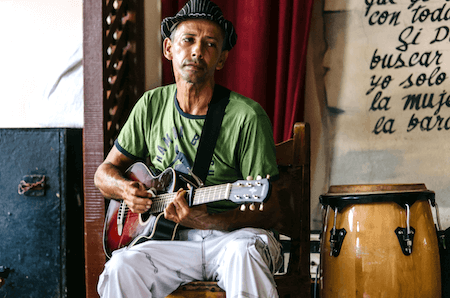
Baracoa exercised its witchcraft over this elegant woman and in return the attractive blonde bewitched the population. She put down roots and in 1944 she obtained Cuban citizenship. Four years later the couple gave up their other business activities, and using space previously occupied only by prickly pears and sea grapes, right in front of the Atlantic Ocean, they built a hotel. It was completed in 1953 and they called it Miramar. The life of the city soon came to centre on it and it was extensively used by businessmen, Americans based at the Guantanamo base and in Nicaro and even by Errol Flynn. In the register of guests of the Hotel La Rusa, as the people called it, appear the names of Fidel, Celia and Antonio Núñez Jiménez (29th January1960), but they are not the only personalities: in the space allocated to 25th March are the signatures of Ernesto Che Guevara, Raúl, Vilma Espin y Aleida March.
Her own prosperity did not blind La Rusa to the fate of the people. She felt for the struggling people around her and identified with the youthful movement which attempted from 1953 onwards to combat the tyranny of Fulgencio Batista. She helped them with money and medicines and thus paradoxically became involved in a revolutionary process of the same stamp as that which she so precipitately fled at the beginning of the twentieth century. Magdalena, Mima, La Rusa… her name marks a period of the history of the First Settlement of the Island of Cuba, where she inscribed her name as one of the most universal women of Baracoa.
Cayamba, Oscar Montero
Oscar Montero Gonzáles was born in the neighbourhood of La Playa, Baracoa, on 8th September 1924, son of Ciro and Ambrosina. He owes his nickname to a doll from the tailor’s “House of Memories’ which attracted and delighted everyone and a friend (Pedro Limia, a singer) called him Cayamba because it was so pleasant to be in his company.
He was a solderer at the Omnibus Company but his transcendent qualities were his charisma and his self-taught talents as a singer. It was as the latter that he earned the affection, respect and admiration of his people. Cayamba shared the stage with the likes of Pablo Milanes, Silvio Rodríguez, Leo Brouwer, Félix Varela, Sara González, Vicente Feliú, Pacho Alonso, Cándido Fabre, Tony Cortes, Aurora Basnuevo and other important Cuban cultural personalities. He is considered Baracoa’s greatest singer. He died on 5th September 1991, but the sound of his guitar and percussion still echo through the streets of my city, as does the voice of the singer which we do not agree to have been the ugliest in the world.
 Exploring Baracoa in Cuba
Exploring Baracoa in Cuba
Baracoa is a city located in the eastern province of Guantanamo (Republic of Cuba). It was the first town founded by the Spanish in Cuba. In her the first cathedral that the country had was erected. It’s the oldest city of Cuba for being the first population that the Spanish founded in the island, with the name of Villa of Our Lady of the Assumption of Baracoa Cuba, on August 15, 1511, on having initiated the colonization of the Island in the 16th century. Its name is of Arawak origin, and means ‘highlands’.
Today, it is called Ciudad Primada de Cuba (Prime City of Cuba), Ciudad Paisaje (City of Landscapes), Ciudad de las Aguas (City of Waters) and Ciudad de las Montañas (City of Mountains); it is surrounded by mountainous massifs, adorned by a rigorous vegetation of virgin forests, full of endemic flora and fauna, with crystalline rivers and beaches surrounded by coves, almond and coconut trees, which makes it possess a distinctive stamp, if compared to the rest of the country. Declared a National Monument, the city is bathed by the Miel River and its natural attractions include the Toa, Yumurí and Yunque de Baracoa Cuba Rivers.
Main Sights
- Museo Arqueológico ‘La Cueva del Paraíso’
- Parque Natural Majayara
- Fuerte Matachín
- Casa del Cacao
- Castillo de Seboruco
- Catedral de Nuestra Señora de la Asunción
- Playa Duaba
- Fuerte de la Punta
- Bust of Hatuey
- Poder Popular de Baracoa Cuba
Parque Natural Majayara
Southeast of town in the Parque Natural Majayara are a couple of magical hikes and swimming opportunities plus an archeological trail in the grounds of a lush family farm. It’s a very low-key, DIY diversion. Passing the Fuerte Matachín, hike southeast past the baseball stadium and along the dark-sand beach for 20 minutes to the Río Miel, where a long low bridge crosses the river. On the other side, bear left following a track up through a cluster of rustic houses to another junction. A guard post here is sometimes staffed by a park official collecting entry fees.
Turn left again and continue along the vehicle track until the houses clear and you see a signposted, single-track path leading off left to Playa Blanca, an idyllic spot for a picnic. Staying straight on the track, you’ll come to a trio of wooden homesteads. The third of these houses belongs to the Fuentes family. For a donation, Señor Fuentes will lead you on a hike to his family finca (farm), where you can stop for coffee and tropical fruit. Further on he’ll show you the Cueva de Aguas, a cave with a sparkling, freshwater swimming hole inside. Tracking back up the hillside you’ll come to an archeological trail with more caves and marvelous ocean views.
 Catedral de Nuestra Señora de la Asunción
Catedral de Nuestra Señora de la Asunción
After years of neglect, Baracoa Cuba hurricane-battered historic cathedral has been lovingly restored using primarily Italian funding. There’s been a building on this site since the 16th century, though this present, much-altered, incarnation dates from 1833. The church’s most famous artifact is the priceless Cruz de la Parra, the only survivor of 29 wooden crosses erected by Columbus in Cuba on his first voyage in 1492. Carbon dating has authenticated the age of the cross (it dates from the late 1400s), but has indicated it was originally made out of indigenous Cuban wood, thus disproving the legend that Columbus brought the cross from Europe.
Casa Del Cacao
Baracoa Cuba, you will quickly ascertain (via your nose), is the center of Cuba’s chocolate industry; cacao is grown hereabouts and subsequently chocolate-ized in a local factory. Thus this museum with cafe chronicles the history of cacao and its importance in eastern Cuba as well as offering cups full of the pure, thick stuff (hot or cold) in a pleasant indoor cafe. It also sells bars of dark, agreeably bitter Baracoan chocolate.
Baracoa´s History
Discovery
Admiral Christopher Columbus arrived in Baracoa Cuba on November 27, 1492. He found there a nature full of beauty, a kind and developed population, descendant of the Arawak, and an elevation that he described in his diary as “a high and square mountain that looked like an island”.
The choice of the site where the village would be created dates from 1510 or early 1511, with all the regulations that existed for it, but it was not until August 15, 1511 that Diego Velázquez de Cuéllar founded the village “Nuestra Señora de la Asunción de Baracoa”, the first Spanish population on the island on the north-eastern coast, which the Indians called Baracoa Cuba (‘high land’ in the Arhuaco language).
On 28th October 1492, Admiral Christopher Columbus arrived at the island of Cuba, which he named “Juana” in honour of Prince Juan, firstborn son of the Spanish monarchs Ferdinand and Isabella. He subsequently altered this name to that of “Fernandina”; a decision which was confirmed by a Royal Decree in February 1515. In spite of this, our island has been known by its original Indian name, “Cuba”, since the first moments of its conquest by Spain.
On the evening of 26th November 1492, the Admiral found himself before the coast of Baracoa, but owing to the lateness of the hour, he decided to wait until dawn on the 27th to disembark, writing in his diary, “… and I found a large bay… and at the end of it to the south east, there is a high, square mountain which looks like an island… “. This is considered irrefutable evidence that he was describing Baracoa and El Yunque.
Nuestra Señora de la Asunción, Baracoa
Baracoa was discovered by Admiral Christopher Columbus during his first voyage, on 27th November 1492. He was forced by bad weather to remain there for several days. On Saturday 1st December he formally took possession of the area in the name of the Spanish crown, erecting a cross as related by Brother las Casas: ‘…he placed a large cross at the entrance of that port, which I believe he called Porto Santo…’.
The Viceroy of Hispaniola was at the time Diego Columbus, the Admiral’s son; it was he who was to send Diego Velásquez to conquer and populate the island of Cuba, for the accomplishment of which he had to vanquish the indigenous resistance organised by Chief Hatuey. The first settlement was founded on the shores of a natural harbour on the north coast, known by the Indians as Baracoa. At some point between 1510 and 1511 the Spanish dubbed it Our Lady of the Assumption.
Friar Bartolomé de las Casas petitioned the king to dissolve the settlement on the grounds of ill-treatment of the Indians, but this did not take place since Baracoa was only Spanish settlement established in the island for a period of approximately three years. It was the only settlement with a town council building and a church, so it was considered the first capital of the island until its founder, Diego Velazquez, established himself in Santiago. In 1516 Baracoa was confirmed as archbishopric of the island in a papal bull issued by Leon X, and it preserved that status until Pope Adrian VI authorised the transfer of the privilege to Santiago on 8th May 1523.
Don Diego Velásquez, lived in Baracoa until 4th October 1513 and it was from this port that Francisco de Morales and Pánfilo de Narváez departed, on his orders, to colonise the rest of the island. Her Majesty the Queen bestowed its coat of arms upon the city in 1538. Guama, the Indian chief of the area, is still famous for his efforts to liberate the indigenous people from the Spanish yoke. Baracoa is the only settlement which has remained in the same place since it was founded. It was proclaimed a national Monument on 4th November 1978 by Dr. Antonio Núñez Jiménez.
San Salvador de Bayamo
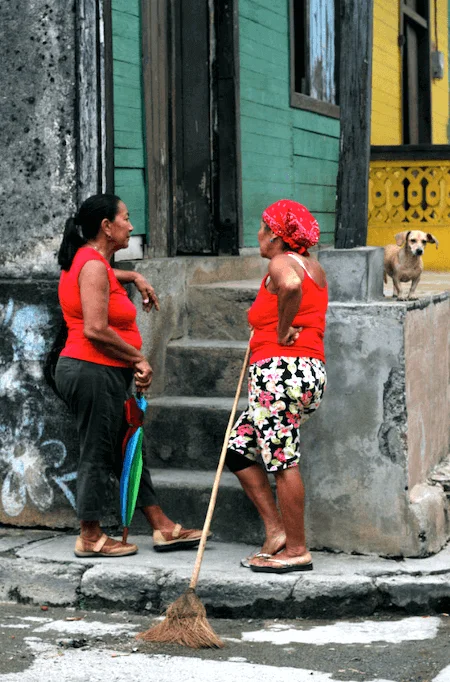
Santísima Trinidad
Founded in January 1514, according to Diego Velásquez, some leagues from the port of Jagua, on the banks of the River Arimao. A few months later it was moved to the place in which it has remained ever since, near the port of Casilda, in accord with a Royal Decree approving the change, received by the governor in December 1514. This is the best remaining example of colonial city, for which reason it was declared a UNESCO World Heritage Site in 1988.
Sancti Spíritus
Founded in 1514, in the place which was believed to be the centre of the island. Shortly afterwards it was moved to the banks of the River Yayabo, its current site.
Santa Maria de Puerto Príncipe (now Camagüey)
Founded in the northern part of the current province of Camagüey. Soon afterwards in 1516 it was moved to the Indian village of Caonao until 1528-1530 when it was again relocated on the banks of the River Tinima where it has remained until our times. Today it is referred to as the city of the Tinajones (large clay water jars).
Santiago de Cuba
Discovered by the Admiral during his second voyage on 14th March 1494. It was founded in July 1515 on the western side of the bay, but a year afterwards it was transferred to the eastern side. In 1517 it was given a coat of arms and in 1522 the bishopric was located in this settlement, which obtained the title of city by Royal Decree on 28th April 1523. It in stands the sanctuary of the Virgin of Caridad del Cobre, Patron Saint of Cuba, the Cemetery of Santa Ifigenia, which holds the remains of our Apostle of Independence José Julián Martí Pérez together with those of other notable patriots, and the Castle of San Pedro de La Roca, declared a UNESCO World Heritage Site in 1997.
San Cristóbal de La Habana
Founded on the south coast, whence it was transferred in 1516 to the northern coast near the River Chorrera (Almendares); from there it moved to the port of Carenas, where the current city was founded. In 1553 it was ceated third and final capital of the island.
Since the end of the seventeenth century the 16th November has been celebrated as the day of its foundation, according to the historian of the city Eusebio Leal. Owing to the strategic advantages possessed by Havana in the context of the establishment of maritime trade routes and the corresponding fortification of the port, by Royal Decree on 16th June 1561 it was given the title of Key of the New World. It was declared a UNESCO World Heritage Site on 14th December 1982.
These were not the only settlements founded by the conquistadors of Cuba. El Cayo or La Savana (now San Juan de Remedios), in the northern part of the central zone, was laid out at the same time as or very shortly after Trinidad and Santi Spíritus, but it had no town council and was not given the official title of Town until over half a century later, a fact referred to by Bishop Diego Sarmiento in his account of his 1544 visit.
Official Coat of Arms of Baracoa
On 14th November 1837, the town council requested a coat of arms from Her Majesty the Queen of Spain Maria Cristina de Habsburgo y Lorena. This was granted on the grounds of Baracoa’s being the first settlement to be founded and to have a town council and church. Not only did it receive a coat of arms, but also the official title of “Very Faithful’, the grant for which arrived with the heraldic design. The date of the decree was 20th September 1838 but it was not until 20th December that the news was received. In 1919 the design was carved in hardwood by Quintiliano Ulloa.
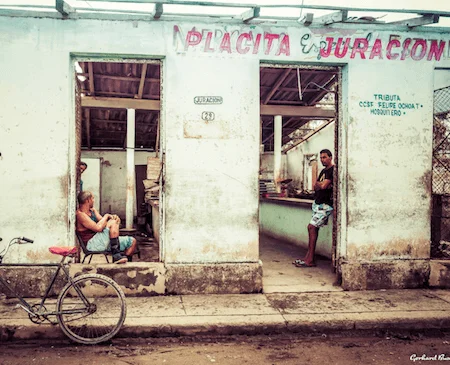
- Superior part: crown of Castile, having the Christian cross above it
- Upper left quadrant – a dog, sign of faithfulness, with the torch of civilization in its mouth
- Upper right quadrant – coconut palm, which represents local flora.
- Lower left quadrant – the port of Las Palmas, the Yunque and the town, representing the first settlement and a useful landmark for the sailors
- Lower right quadrant – a caravel, the ship in which Diego Velásquez arrived to colonise Cuba
- Around the shield a ribbon which has written on it in Latin OMNIUM CUBE EXIGUA TAMENT SI TEMPORE PRIMAS FERENS, meaning ALTHOUGH IT IS THE SMALLEST CITY OF CUBA IT WILL ALWAYS BE THE FIRST.
In the museum in the Matachín Fortress one may still see the original coat of arms which was carved in 1919.
The Sacred Cross of Parra
On 1st December 1492 Friar Bartolomé de las Casas wrote “He placed a large cross at the entrance of that port, which I believe he named Porto Santo’. The Sacred Cross of Parra is considered the oldest artifact connected with Columbus to be found on the American Continent, which makes it part of the World’s Historical-Cultural Heritage.
This historical and religious relic was honoured in a special manner by Bishop Morell de Santa Cruz, who in January 1757 ordered an altar to be made for it, thus providing it with a more dignified context in which to be worshipped. Already at that date the church had been provided with the baptismal font which is still preserved there. The Cross was never, however, displayed with the pomp it deserved; it was as if the people of Baracoa thought that if they made too much of it, there might be a fresh attempt to take it to Santiago, which happened when the status of capital and the island’s first bishopric was transferred to that city.
It was protected from the early attacks by pirates and corsairs, and from the more modern “attacks’ by notable personages in the island, many of whom decided to award themselves a little piece of it (an example was General Martínez Campos, whose capricious appropriation of part of the relic reduced it to its current dimensions: 1.10m x 0.56m). All this caused the order to be given for the cross to be measured with the purpose of encasing its extremities in metal, to avoid the continuous cuts to which it was being subjected. The metal plates which were put on by Dolores Delabat, with the vicar’s permission.
A challenge was issued in connection with the cross on 10th June 1984, published by Ángel Tomás and Leonardo Padura in the newspaper Rebel Youth. The graduate Raquel Carrera Rivery – specialist in the anatomy of wood at the Institute of Forestry Research of the Ministry of Agriculture – became interested in the matter and decided to participate in the historical investigations undertaken by Alejandro Hartmann, Director of the Matachin Fort Municipal Museum. It was thus that Mystical Conviction became Scientific Conviction. The foundations of the work were laid when Professor Roger Dechamps, specialist in wood at the Museum of Central Africa in Tervuren, Belgium, became interested in undertaking an analysis of the origins and nature of the wood of which this famous relic had been made.
The first microscopic tests of fragments of the Sacred Cross of Parra, with which Professor Dechamps was helped by the parish priest Valentín Sáenz, were carried out in the microbiology laboratory with the support of Oscar Jardines. Although these tests proved inconclusive, they demonstrated the interest of the people of Baracoa in rescuing their historical artefacts.
A few months later, Professor Thomas Avella from the University of Lovaina la Nueva undertook carbon dating and structural studies on fragments taken from the Cross, which provided conclusive results: it was possible to determine that the wood is Coccoloba from the Polygonacae family, very probably Coccoloba diversifolia, known in Cuba as Uvilla, which grows on the coasts and in the mountains of Cuba and the Antilles and not in Europe as was preciously believed.
The carbon dating gave indisputable results that the piece was authentic, with the biological age of the wood corresponding to the date of discovery. According to the carbon dating the date of the wood could be located with 95% accuracy between 860 and 1530. During the visit to Cuba of His Holiness Pope John Paul II, in the mass held in Santiago on 24th January 1998, the faithful presented him with the Sacred Cross of Parra, but he said “I will take it in my heart but you, who have venerated it and looked after it for so long, must return it to Baracoa and preserve it for the enjoyment of future generations.’
 Landings
Landings
The mountainous topography of the region, its isolation from other large cities and the natural patriotism of its inhabitants caused the conspirators and revolutionaries of the colonial period to prefer it for armed landings in the pursuit of liberty. In October 1854, the expedition of Francisco Estrampes y Gómez, Juan Enrique Félix and José Elías Hernández landed at the port of Baracoa.
Cuban War of Independence
On 16th March 1895 a landing took place at Caleta beach. It consisted of two boats, in the first of which were General Limbazo Sánchez y Colonel Francisco Varona with four other men. In the second boat were Brigadier Ramón González and the rest of the expeditionaries; they landed far away from their companions and did not meet up with them until 10 days afterwards.
On 30th March 1895 there was a landing at Duaba beach, from the British schooner Honour. This was an expedition from Santa Domingo (or possibly Costa Rica) formed by Generals Flor Crombet, Antonio Maceo, José Maceo and Agustín Cebreco, Brigadiers Silverio Sánchez Figueras and Adolfo Peña, Colonels Patricio Corona, Alcid Duverger, José Arceno and José Palacios, Lieutenant-Colonel Alberto Boix, Commanders Juan Fustiel and Juan Limonta, Captains Joaquín Sánchez, Francisco Agramonte, Jesús Maria Santini, Isidoro Noriega, Manuel de J. Granda and Domingo Guamán, Lieutenants Jorge Travot Estrada and Tomas Julio Sáenz and Sub-Lieutenants Luis Enríquez and Luis Soler.
The schooner was wrecked and a few days later Flor Crombet was killed in a battle with the Spaniards. Latter they attacked Maceo at Duaba but were repulsed. Agramonte captured. Provisional government proclaimed by Maceo; Dr. Tomás Estrada Palma, president, José Martí, secretary-general, and General Máximo Gómez, military director and commander-in-chief.
On 11th April 1895, a landing took place on the small beaches of Cajobobo from a boat bought in the island of Great Inagua for one hundred pesos and launched from the German steamship Nordstrand. This group consisted of the liberators Máximo Gómez Báez, José Martí Pérez, Ángel Guerra, Cesar Salas and Marcos Mendosa Rosario. On 19th August 1895 the Norwegian steamship Lion arrived at Nibujón beach, commanded by General Francisco Sánchez Echevarria with 40 revolutionaries. On 28th October 1895, another revolutionary band arrived at Caleta beach, in the steamship Laurada, under the civil command of Carlos Manuel de Céspedes y Quesada, son of the Father of the Fatherland and of the military Commander José López, with 38 expeditionaries. On 25th March 1896, a landing took place at Maraví beach from the steamship Bermudas, under the maritime command of General Emilio Núñez and the military leadership of Calixto García Iñiguez, with 68 expeditionaries.

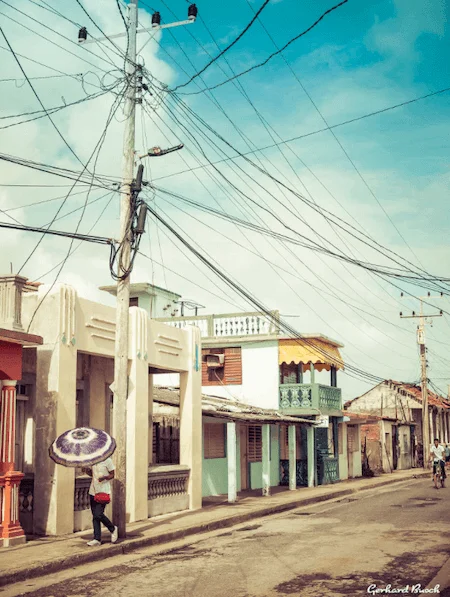 Martí Park
Martí Park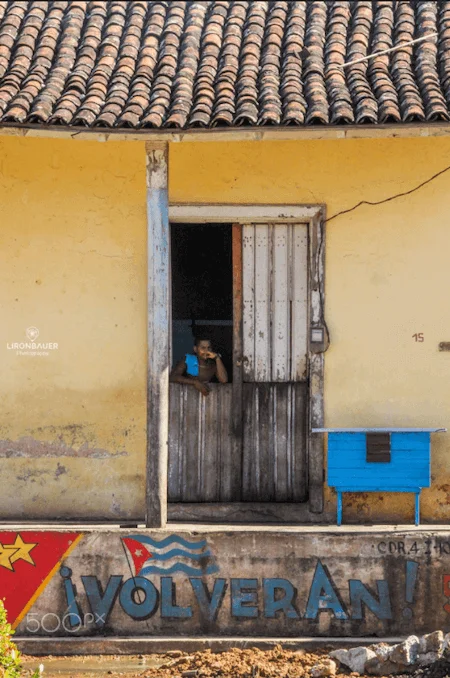
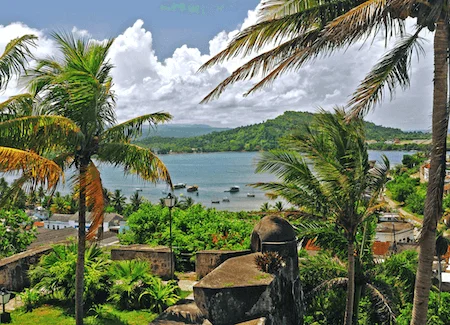 El Yunque
El Yunque Hatuey
Hatuey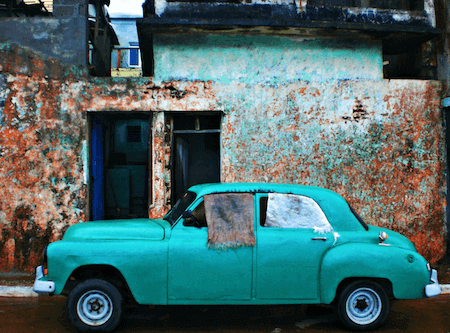 Exploring Baracoa in Cuba
Exploring Baracoa in Cuba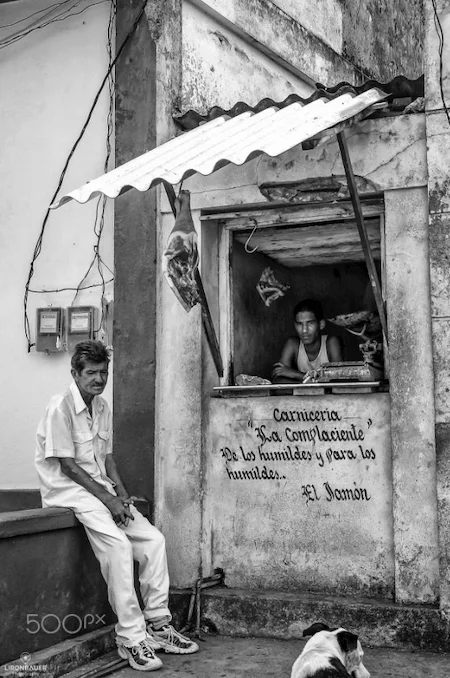 Catedral de Nuestra Señora de la Asunción
Catedral de Nuestra Señora de la Asunción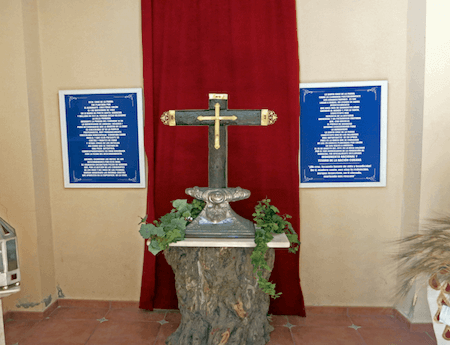 Landings
Landings